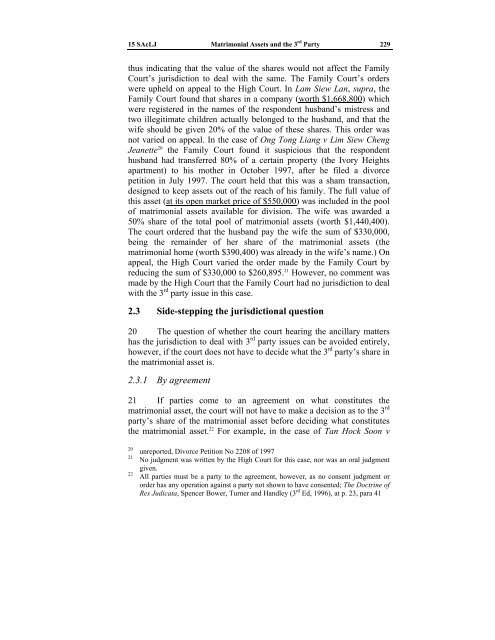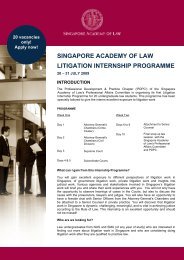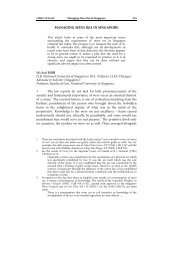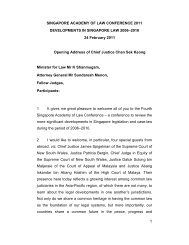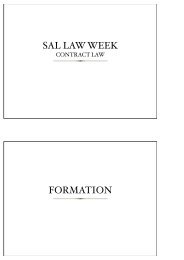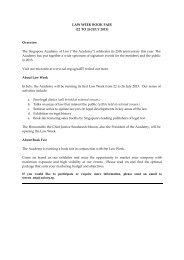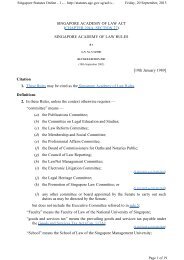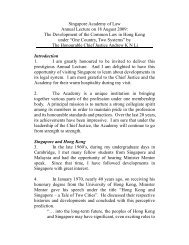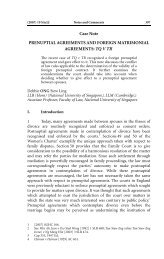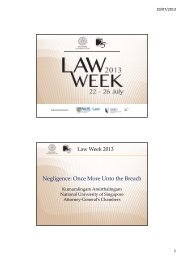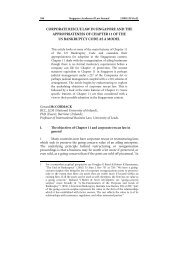View Article - Singapore Academy of Law
View Article - Singapore Academy of Law
View Article - Singapore Academy of Law
Create successful ePaper yourself
Turn your PDF publications into a flip-book with our unique Google optimized e-Paper software.
15 SAcLJ Matrimonial Assets and the 3 rd Party 229<br />
thus indicating that the value <strong>of</strong> the shares would not affect the Family<br />
Court’s jurisdiction to deal with the same. The Family Court’s orders<br />
were upheld on appeal to the High Court. In Lam Siew Lan, supra, the<br />
Family Court found that shares in a company (worth $1,668,800) which<br />
were registered in the names <strong>of</strong> the respondent husband’s mistress and<br />
two illegitimate children actually belonged to the husband, and that the<br />
wife should be given 20% <strong>of</strong> the value <strong>of</strong> these shares. This order was<br />
not varied on appeal. In the case <strong>of</strong> Ong Tong Liang v Lim Siew Cheng<br />
Jeanette 20 the Family Court found it suspicious that the respondent<br />
husband had transferred 80% <strong>of</strong> a certain property (the Ivory Heights<br />
apartment) to his mother in October 1997, after he filed a divorce<br />
petition in July 1997. The court held that this was a sham transaction,<br />
designed to keep assets out <strong>of</strong> the reach <strong>of</strong> his family. The full value <strong>of</strong><br />
this asset (at its open market price <strong>of</strong> $550,000) was included in the pool<br />
<strong>of</strong> matrimonial assets available for division. The wife was awarded a<br />
50% share <strong>of</strong> the total pool <strong>of</strong> matrimonial assets (worth $1,440,400).<br />
The court ordered that the husband pay the wife the sum <strong>of</strong> $330,000,<br />
being the remainder <strong>of</strong> her share <strong>of</strong> the matrimonial assets (the<br />
matrimonial home (worth $390,400) was already in the wife’s name.) On<br />
appeal, the High Court varied the order made by the Family Court by<br />
reducing the sum <strong>of</strong> $330,000 to $260,895. 21 However, no comment was<br />
made by the High Court that the Family Court had no jurisdiction to deal<br />
with the 3 rd party issue in this case.<br />
2.3 Side-stepping the jurisdictional question<br />
20 The question <strong>of</strong> whether the court hearing the ancillary matters<br />
has the jurisdiction to deal with 3 rd party issues can be avoided entirely,<br />
however, if the court does not have to decide what the 3 rd party’s share in<br />
the matrimonial asset is.<br />
2.3.1 By agreement<br />
21 If parties come to an agreement on what constitutes the<br />
matrimonial asset, the court will not have to make a decision as to the 3 rd<br />
party’s share <strong>of</strong> the matrimonial asset before deciding what constitutes<br />
the matrimonial asset. 22 For example, in the case <strong>of</strong> Tan Hock Soon v<br />
20<br />
21<br />
22<br />
unreported, Divorce Petition No 2208 <strong>of</strong> 1997<br />
No judgment was written by the High Court for this case, nor was an oral judgment<br />
given.<br />
All parties must be a party to the agreement, however, as no consent judgment or<br />
order has any operation against a party not shown to have consented; The Doctrine <strong>of</strong><br />
Res Judicata, Spencer Bower, Turner and Handley (3 rd Ed, 1996), at p. 23, para 41


